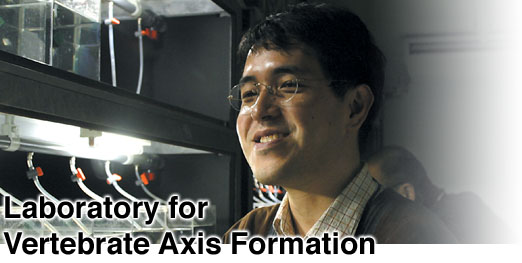




     |

During early vertebrate development, the embryonic dorso-ventral (DV) and anterior-posterior (AP) axes are established through a series of inductive signals that prefigure and determine the concerted movements and differentiation of a group of cells. The dorsal organizer plays a major role in the process of axis formation. In amphibian and teleost fish embryogenesis, the program for dorsal organizer formation begins soon after fertilization. In these species, dorsal determinants are believed to be initially localized to the vegetal pole and later transported to the dorsal side of the embryo.
Although the molecular nature of the dorsal determinants has not been elucidated, they are known to activate the canonical Wnt pathway and thereby lead to the expression of genes involved in the induction of the dorsal organizer. The dorsal organizer generates secreted signaling molecules that participate in the generation of the DV axis in the mesoderm and endoderm, and the formation of the neuroectoderm. We are working to identify the molecules that are involved in the formation and function of the dorsal organizer. This search led us to identify the protein Secreted Frizzled (Sizzled)/Ogon as a negative feedback regulator of BMP signaling that cooperates with the dorsal organizer protein Chordin to regulate DV axis formation. We also remain actively interested in determining the molecular identities of dorsal determinants.
Neural patterning and neurogenesis as a model of cell fate determination, a process that is linked to axis formation, is also a question of interest to our team. Neuronal tissues are generated in a stepwise manner in vertebrates. These steps include neural induction, AP patterning and neurogenesis. In amphibian and teleost embryos, neuroectoderm is initially induced by BMP inhibitors (such as Chordin), which are generated by the dorsal organizer. The induced neuroectoderm is characteristically anterior in character and is only subsequently subjected to posteriorization, which involves signaling by posteriorizing factors emanating from the non-axial mesendoderm. After neural induction and patterning, the proneuronal domains, in which neurogenesis takes place, are established. Within the proneuronal domains, a subset of cells is selected to become primary neurons by a Notch-mediated lateral inhibition mechanism. We have recently found that the homeobox gene pnx is regulated by the posteriorizing non-axial mesendoderm and Notch signaling, and that Pnx is involved in the development of posterior neurons. We are trying to determine the mechanism by which the formation of primary neurons is spatially regulated.